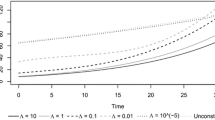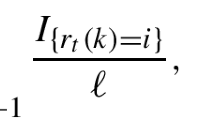Abstract
Twenty years ago, E.R. Fernholz introduced the notion of “functional generation” to construct a variety of portfolios solely in terms of the individual companies’ market weights. I. Karatzas and J. Ruf recently developed another approach to the functional construction of portfolios which leads to very simple conditions for strong relative arbitrage with respect to the market. Here, both of these notions are generalized in a pathwise, probability-free setting; portfolio-generating functions, possibly less smooth than twice differentiable, involve the current market weights as well as additional bounded-variation functionals of past and present market weights. This leads to a wider class of functionally generated portfolios than was heretofore possible to analyze, to novel methods for dealing with the “size” and “momentum” effects, and to improved conditions for outperforming the market portfolio over suitable time horizons.



Similar content being viewed by others
References
Cont, R.: Functional Itô calculus and functional Kolmogorov equations. In: Utzet, F., Vives, J. (eds.) Stochastic Integration by Parts and Functional Itô Calculus. Advanced Courses in Mathematics—CRM Barcelona, pp. 115–201. Birkhäuser, Basel (2016)
Cont, R., Fournié, D.A.: Functional Itô calculus and stochastic integral representation of martingales. Ann. Probab. 41, 109–133 (2013)
Cont, R., Perkowski, N.: Pathwise integration and change of variable formulas for continuous paths with arbitrary regularity. Trans. Am. Math. Soc. 6, 161–186 (2019)
Davis, M., Obłój, J., Siorpaes, P.: Pathwise stochastic calculus with local times. Ann. Inst. Henri Poincaré Probab. Stat. 54, 1–21 (2018)
Dupire, B.: Functional Itô calculus. Bloomberg Portfolio Research Paper 2009-04 (2009). Available online at: https://doi.org/10.2139/ssrn.1435551
Ekren, I., Keller, C., Touzi, N., Zhang, J.: On viscosity solutions of path dependent PDEs. Ann. Probab. 42, 204–236 (2014)
Ekren, I., Touzi, N., Zhang, J.: Viscosity solutions of fully nonlinear parabolic path dependent PDEs: part I. Ann. Probab. 44, 1212–1253 (2016)
Ekren, I., Touzi, N., Zhang, J.: Viscosity solutions of fully nonlinear parabolic path dependent PDEs: part II. Ann. Probab. 44, 2507–2553 (2016)
Fernholz, E.R.: Stochastic Portfolio Theory. Springer, New York (2002)
Fernholz, E.R., Karatzas, I., Ruf, J.: Volatility and arbitrage. Ann. Appl. Probab. 28, 378–417 (2018)
Fernholz, R.: Portfolio generating functions. In: Avellaneda, M. (ed.) Quantitative Analysis in Financial Markets, pp. 344–367. World Scientific, Singapore (1999)
Fernholz, R., Karatzas, I.: Stochastic portfolio theory: an overview. In: Bensoussan, A. (ed.) Handbook of Numerical Analysis, Mathematical Modeling and Numerical Methods in Finance, pp. 89–167. Elsevier, Amsterdam (2009)
Föllmer, H.: Calcul d’Itô sans probabilités. In: Azéma, J., Yor, M. (eds.) Séminaire de Probabilités, XV. Lecture Notes in Mathematics, vol. 850, pp. 143–150. Springer, Berlin (1981)
Karatzas, I., Ruf, J.: Trading strategies generated by Lyapunov functions. Finance Stoch. 21, 753–787 (2017)
Kim, D.: Local times for continuous paths of arbitrary regularity. Preprint (2019). Available online at: https://arxiv.org/abs/1904.07327
Leão, D., Ohashi, A.: Weak approximations for Wiener functionals. Ann. Appl. Probab. 23, 1660–1691 (2013)
Leão, D., Ohashi, A., Simas, A.B.: Weak differentiability of Wiener functionals and occupation times. Bull. Sci. Math. 149, 23–65 (2018)
Leão, D., Ohashi, A., Simas, A.B.: A weak version of path-dependent functional Itô calculus. Ann. Probab. 46, 3399–3441 (2018)
Perkowski, N., Prömel, D.: Local times for typical price paths and pathwise Tanaka formulas. Electron. J. Probab. 20, 1–15 (2015)
Ruf, J., Xie, K.: Generalised Lyapunov functions and functionally generated trading strategies. Appl. Math. Finance (2019, forthcoming). Available online at: https://doi.org/10.1080/1350486X.2019.1584041
Schied, A., Speiser, L., Voloshchenko, I.: Model-free portfolio theory and its functional master formula. SIAM J. Financ. Math. 9, 1074–1101 (2018)
Sondermann, D.: Introduction to Stochastic Calculus for Finance. A New Didactic Approach. Lecture Notes in Economics and Mathematical Systems, vol. 579 (2006)
Strong, W.: Generalizations of functionally generated portfolios with applications to statistical arbitrage. SIAM J. Financ. Math. 5, 472–492 (2014)
Strong, W.: Fundamental theorems of asset pricing for piecewise semimartingales of stochastic dimension. Finance Stoch. 18, 487–514 (2014)
Würmli, M.: Lokalzeiten für Martingale, Diploma Thesis. ETH Zürich (1980). Unpublished
Acknowledgements
We are very grateful to the referees, the Associate Editor and the Co-Editor for calling our attention to a serious conceptual error in an earlier version of this paper, as well as for their many and constructive comments which helped us improve drastically the quality of this work. We thank also Drs. Robert Fernholz, Johannes Ruf and Rama Cont for many discussions and suggestions. Research supported in part by the National Science Foundation under grant NSF-DMS-14-05210.
Author information
Authors and Affiliations
Corresponding author
Additional information
Publisher’s Note
Springer Nature remains neutral with regard to jurisdictional claims in published maps and institutional affiliations.
Appendix: Proofs
Appendix: Proofs
Proof of Proposition 3.9
We follow the argument in [14, Proposition 4.8], using the pathwise Itô formula instead of the standard Itô formula for semimartingales. With
in (3.23), the pathwise Itô formula (Proposition 2.2) yields
Here, the second equality uses the expression in (3.4) and the last equality relies on [14, Proposition 2.3]. Since (3.23) holds at time zero, it follows that (3.23) holds at any time \(t \in [0, T]\). The justification for (3.24) is exactly the same as that of [14, Proposition 4.8]. □
Proof of Theorem 3.10
For any absolutely continuous function \(f\) with a right-continuous Radon–Nikodým derivative \(f'\) of finite variation and any two real numbers \(a\) and \(b\), applying integration by parts with the notation (2.3) gives

We then recall (3.5), (3.6), (A.1) and consider the telescoping expansion
Then we further expand the last double sum (A.4) as

where the first equation is from (A.2), and the second follows from (3.5) and (2.4).
Next, we show that the sum of (A.3), (A.6) and (A.7) vanishes as \(n \rightarrow \infty \). First, since \(\lim _{n \rightarrow \infty } \Vert {\mathbb{T}}_{n}\Vert =0\), the limit of (A.3) is a Lebesgue–Stieltjes integral
because \(f_{i}(X_{i}(\cdot ))\) is bounded on the compact interval \([0, T]\) for each \(i=1, \dots , d\). From (3.11), the change-of-variable formula for Lebesgue–Stieltjes integrals gives
where
It follows that the limit of (A.6) is \(-\sum _{i=1}^{d} \int _{0}^{t} K(s)\vartheta _{i}(s)dA_{i}(s)\). On the other hand, the last integral of (A.8) can be expressed as the limit
which coincides with the limit of (A.7). Therefore, the limits of (A.3), (A.6) and (A.7) are zero, whereas the remaining term of (A.4) is (A.5), whose limit we denote as
from (3.6) and (3.21). We obtain in this way that
where the last equality follows from \(\sum _{i=1}^{d} \mu _{i}(\cdot ) \equiv 1\) and (3.22). The result (3.23) then follows from the self-financibility of \(\psi \) and the relationship
Finally, (3.24) can be justified in the same manner as Proposition 3.9. □
Rights and permissions
About this article
Cite this article
Karatzas, I., Kim, D. Trading strategies generated pathwise by functions of market weights. Finance Stoch 24, 423–463 (2020). https://doi.org/10.1007/s00780-019-00414-2
Received:
Accepted:
Published:
Issue Date:
DOI: https://doi.org/10.1007/s00780-019-00414-2
Keywords
- Stochastic portfolio theory
- Pathwise Itô and Tanaka formulas
- Trading strategies
- Functional generation
- Strong relative arbitrage




